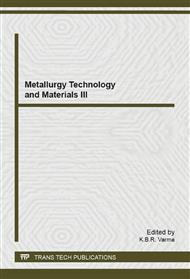[1]
A. Kumar, L. D. Stephenson, J. N. Murray. Self-healing Coatings for Steel. Progress in Organic Coatings, 2006 (55) , p.244–253.
DOI: 10.1016/j.porgcoat.2005.11.010
Google Scholar
[2]
V. Sauvant-Moynot, S. Gonzales, J. Kittel. Self-healing Coatings: An Alternative Route for Anticorrosion Protection. Progress in Or ganic Coatings, 2008(63), p.307–315.
DOI: 10.1016/j.porgcoat.2008.03.004
Google Scholar
[3]
B. J. Blaiszik, N. R. Sottos, S. R. White. Nanocapsules for Self-healing Materials. Composites Science and Technology, 2008(68), p.978–986.
DOI: 10.1016/j.compscitech.2007.07.021
Google Scholar
[4]
S. H. Cho, S. R. White, P. V. Braun. Self-healing Polymer Coatings. Advanced Materials, 2009(21), p.645–649.
DOI: 10.1002/adma.200802008
Google Scholar
[5]
S. J. García, H. R. Fischer, S. van der Zwaag. A Critical Appraisal of the Potential of Self-healing Polymeric Coatings. Progress in Organic Coatings, 2011(72), p.211–221.
DOI: 10.1016/j.porgcoat.2011.06.016
Google Scholar
[6]
M. Samadzadeh, B. S. Hatami, M. Peikari, S. M. Kasiriha, A. Ashrafi. A Review on Self-healing Coatings Based on Micro/nanocapsules. Progress in Organic Coatings, 2010(68), 159–164.
DOI: 10.1016/j.porgcoat.2010.01.006
Google Scholar
[7]
E.N. Brown, M.R. Kessler, N.R. Sottos, S.R. White. In-situ Poly(urea-formaldehyde) Microencapsulation of Dicyclopentadiene. Journal of Microencapsulation, 2003(20), p.719–730.
DOI: 10.1080/0265204031000154160
Google Scholar
[8]
H. Li, R. Wang, H. Hu, W. Liu. Surface Modification of Self-healing Poly(urea-formaldehyde) Microcapsules Using Silane-coupling Agent. Applied Surface Science, 2008(255), p.1894–(1900).
DOI: 10.1016/j.apsusc.2008.06.170
Google Scholar
[9]
R. Wang, H. Li, H. Hu, X. He, W. Liu. Preparation and Characterization of Self-healing Microcapsules With Poly(urea-formaldehyde) Grafted Epoxy Functional Group Shell. Journal of Applied Polymer Science, 2009(113), p.1501–1506.
DOI: 10.1002/app.30001
Google Scholar
[10]
L. Yuan, G.Z. Liang, J.Q. Xie, S.B. He. Synthesis and Characterization of Microencapsulated Dicyclopentadiene With Melamine–formaldehyde Resins. Colloid and Polymer Science, 2007(285), p.781–791.
DOI: 10.1007/s00396-006-1621-5
Google Scholar
[11]
X. Liu, X. Sheng, J.K. Lee, M.R. Kessler. Synthesis and Characterization of Melamine-urea-formaldehyde Microcapsules Containing ENB-based Self-healing Agents. Macromolecular Materials and Engineering, 2009(294), p.389–395.
DOI: 10.1002/mame.200900015
Google Scholar
[12]
X. Liu, J.K. Lee, M.R. Kessler. Microencapsulation of Self-healing Agents With Melamine-urea-formaldehyde by the Shirasu Porous Glass (SPG) Emulsification Technique. Macromolecular Research, 2011(19), p.1056–1061.
DOI: 10.1007/s13233-011-1009-3
Google Scholar
[13]
S. Emma. Synthesis and Characterization of Microcapusules for Self-healing Materials. C500 Final Report, Blppmington, Department of Chemistry Indiana University, (2006).
Google Scholar
[14]
J. Lee, D. Bhattacharyya, et al. Fracture Behaviour of a Self-healing Microcapsule-loaded Epoxy System. e-XPRESS Polymer Letters, 2011, 5(3): 246-253.
DOI: 10.3144/expresspolymlett.2011.24
Google Scholar
[15]
J. Henghua, L.M. Chris, S.G. Anthony, et al. Microcapsules: Thermally Stable Autonomic Healing in Epoxy Using a Dual-microcapsule System. Advanced Materials, 2014, 26(2): 193.
DOI: 10.1002/adma.201470006
Google Scholar
[16]
M.C. Mary, B.J. Blaiszik, et al. Robust, Double-walled Microcapsules for Self-healing Polymeric Materials. ACS Applied Materials & Interfaces, 2010, 2(4): 1195-1199.
DOI: 10.1021/am100084k
Google Scholar
[17]
T. Song, S. Gan, et al. Optimization of Microencapsulation Process for Self-healing Polymeric Material. Sains Malaysiana, 2011, 40(7): 795-802.
Google Scholar
[18]
Y. Li, C. Feng, Aijiuan G., et al. Synthesis of Poly(urea-formaldehyde) encapsulated Dibutyltin Dilaurate Through the Self-catalysis of Core Materials. Polym. Bull, 2014, (71): 261-273.
DOI: 10.1007/s00289-013-1059-0
Google Scholar
[19]
X.Q. Song, Y.X. Li, J.W. Wang. Preparation and Characterization of Hexadecane Microcapsule Phase Change Materials by In-situ Polymerization. Advanced Materials Research, 2013, 815(367): 367-370.
DOI: 10.4028/www.scientific.net/amr.815.367
Google Scholar
[20]
M. M. Caruso, B. J. Blaiszik, H. Jin, S. R. Schelkopf, D. S. Stradley, N. R. Sottos, S. R. White, J. S. Moore, ACS Appl. Mater. Interfaces, 2010(2), p.1195.
DOI: 10.1021/am100084k
Google Scholar
[21]
H. Jin, C. L. Mangun, D. S. Stradley, J. S. Moore, N. R. Sottos, S. R. White, Polymer 2011(53), p.581.
Google Scholar
[22]
Y. Yan, Y.P. Luo, H.P. Zhang. Preparation and Properties of Self-healing Microcapsules. Journal of Chemical Engineering of Chinese Universities, 2011, 25(3), pp.513-518.
Google Scholar
[23]
M. Aijie , Q.Y. Zhang, H.P. Zhang, et al. A novel single component epoxy resin adhesive with microcapsule latent curing agent of 2-phenylimidazole/polymethyl acrylic glycidyl ester. Materials Science, 2012, 59(78), pp.172-231.
DOI: 10.1177/0095244313516888
Google Scholar
[24]
T. Yoshinari, S. Natsukaze, et al. Preparation of Hybrid Microcapsules and Application to Self-healing Agent. Polymers Advanced Technologies, 2014, 25, pp.41-47.
Google Scholar


